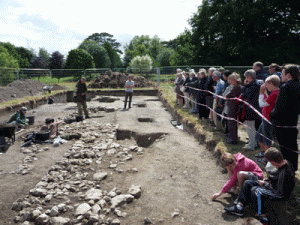Medieval Britain and Ireland
From its beginning in 1957, annual excavation summaries have formed an integral part of reporting by the Society.
Accompanied by an index of period-based keywords, these brief reports have provided a resource for both researchers in the field and the general public. Today, Medieval Britain and Ireland comprises many hundred summaries each year, submitted by archaeological contractors, local governmental bodies and university staff and researchers.

A Public tour of excavations at Wallingford in 2009
Please click here for the on-line resource.
With the reports from 2006 onwards, there are now two different formats for the review. The printed Journal will contain a smaller selection of annual reviews. This ‘Fieldwork Highlights’ section is designed to provide extended overviews of a selection of significant new discoveries each year, aiming to cover a range of Anglo-Saxon, Viking-period and later medieval sites. At the same time, the Society introduces a new searchable digital database for the full annual summaries. Hosted by the ADS as a ‘Special Collections’ feature of Archsearch, the new database will provide access to a wide range of data and unpublished reports through links with the OASIS system. In time, we hope to enter also the backlog of previously published round-ups, making Medieval Britain and Ireland a truly excellent period-based resource. From the beginning of 2010, sites from 2007 and 2008 will be searchable on the new database; summaries from previous years are also accessible as pdf files.
Contribute to Medieval Britain and Ireland
If your company or department is not already submitting annual reports, please consider doing so; reports should be sent to the compiler by the 1st March. Later submissions will still be included in the digital database as can older, not previously reported, summaries. Contributions can include short summaries of fieldwork undertaken, or longer reports which will be included in our ‘Fieldwork Highlights’ section.
Fieldwork summaries
Fieldwork summaries for work undertaken in the last year are short entries which, when combined, will provide readers with an up-to-date gazetteer of archaeological sites investigated.
- summaries should be 100 to 300 words long and be concerned with actual fieldwork (including survey); do not include large elements of historical research, desk-based assessments or unproductive watching briefs.
- all features and finds should be assigned to either the pre-Conquest (Anglo-Saxon) or post-Conquest period; this is to avoid the meaningless or over-vague reference to ‘medieval finds/pit/pottery/surface/wall’ etc.
- in terms of geographical conventions, sites in England will be referred under the post-1974 counties; for Scotland and Wales, the New Local Authority or Unitary Authority Areas will be used; for Ireland, the historic counties will remain. Maps illustrating this system can be found in Medieval Archaeology Vol.44 (2000), 236-38 and Medieval Archaeology Vol.45 (2001), 234.
- national grid reference should be given in conventional form with two letters and six or eight digits (please tell compilers if you are withholding it). For landscape surveys and similar, please provide a central grid reference.
- the online database will include a link to OASIS, so please note: where relevant, the individual OASIS number for each site needs to be included in the submission.
- do supply illustrations (where relevant) with your contributions, in particular plans and elevations. For publication, tiff is the preferable format, but most importantly that the image is high resolution; for publication work, the minimum resolution is 300dpi. This resolution is suitable for photographic images. For line drawings a resolution of 1200dpi is a better starting point. Colour images are welcome; these may be published as half-tones in the Journal but presented in colour in the on-line version. Remember to acknowledge copyright in illustration captions.
Fieldwork highlights
The journal is very keen to include extended and illustrated overviews of fieldwork which has yielded significant results of wider value for readers. See recent issues of our journal for examples of reports on excavation discoveries, standing building studies, etc which have provided new insights into aspects of the early- to late-medieval landscape (urban and rural). The journal includes up to five of these reports each year year dealing with work that has been carried out for the previous year. Please contact the MBI editors (see below) if you have a suitable project to report on.
Reports should be a maximum of 2000 words long, with a short supporting bibliography where appropriate, and up to four black and white or colour plates and figures.
The general editor of Medieval Britain and Ireland is Katie Hemer, who can be contacted by email or by post at:
Dr. Katie Hemer
Associate Professor
Institute of Archaeology
University College London
31-34 Gordon Square
London WC1H 0PY
England, UK


